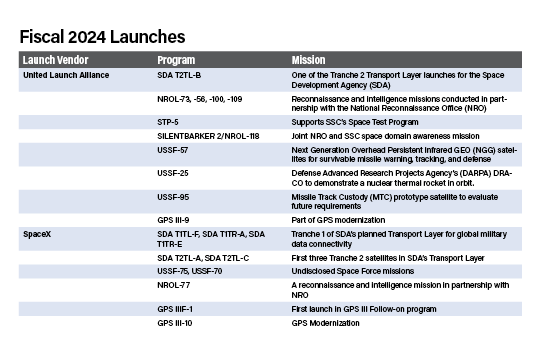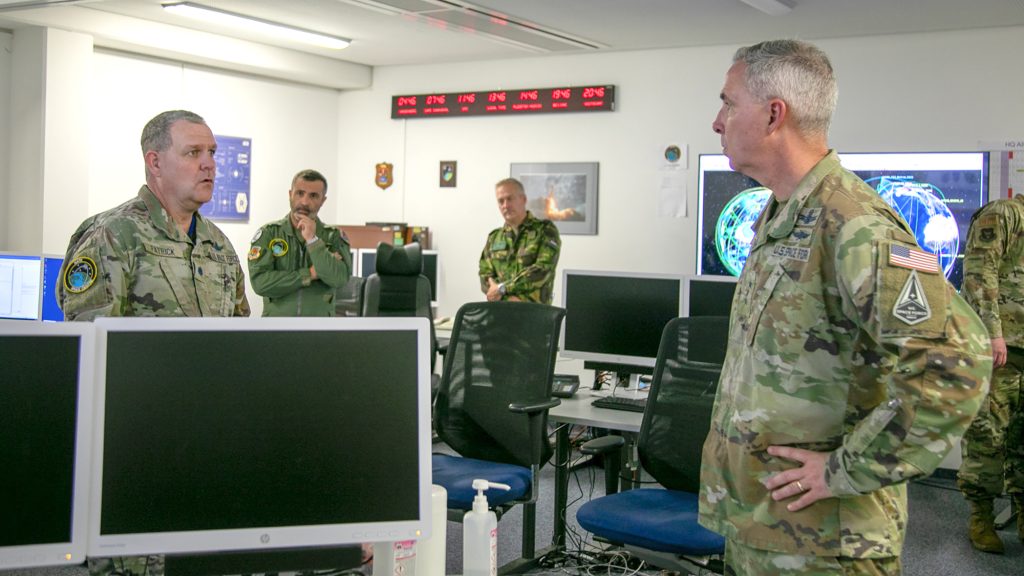
WORLD: Space (Image Credit: airandspaceforces)
USSF Plans 21 Launches in FY24
By Unshin Lee Harpley
The Space Force aims to boost its National Security Space Launch (NSSL) program from 12 launches in fiscal 2023 to 21 missions in 2024, with United Launch Alliance (ULA) responsible for 11 missions and SpaceX handling 10.
Nailing down all the contracting will come in phases, however, as the 2024 budget has yet to pass Congress and be signed into law. Fiscal 2024 began on Oct. 1, but the government is operating under a continuing resolution as lawmakers wrangle over differences.
“The government is only ordering eight missions now, due to continuing resolution,” said Col. Doug Pentecost, deputy program executive officer for Space Systems Command’s Assured Access to Space (SSC/AATS).
If the full program is executed, the launches and associated activities will pay $1.3 billion to ULA and $1.2 billion to SpaceX, Pentecost said.
Pentecost said the Space Force initially planned more ULA launches, but after evaluating readiness, production capacity, and the ability to meet demands, the split was adjusted. Over the entire 48 planned launches in the National Security Space Launch Phase 2 plan, ULA is now expected to be responsible for 26 launch assignments versus 22 for SpaceX. In all, Phase 2 will be substantially larger than the original estimate of 34 launches.
The 48 planned launches, to be executed within the next two to three years, encompass missions ranging from GPS to missile warning and space research and reconnaissance, according to SSC’s announcement.
ULA and SpaceX secured their contracts for Phase 2 in August 2020, outperforming competitors including Northrop Grumman and Blue Origin. After this fifth and final Phase 2 award, the launch program will again be open to competition for Phase 3, which will cover the period from 2025 to 2034. That program is to be split into two segments, or “lanes.”
In Lane 1, SSC will award multiple indefinite delivery/indefinite quantity contracts. These five-year, renewable agreements are intended to increase the Space Force’s launch options and, through competition, to drive down costs. In Lane 2, USSF will award two contractors launch agreements to manage launches into all orbits with comprehensive mission-specific services.
Space Force Readies Europe-Africa Unit
By Chris Gordon
The U.S. Space Force will officially activate its component for Europe and Africa in just over a month, U.S. European Command said Oct. 31.
U.S. Space Forces Europe and Africa, which will be dubbed SPACE-EURAF, will stand up Dec. 8, U.S. European Command (EUCOM) said in a news release. It will become the fourth Space Force component embedded in one of the U.S. military’s regional commands, joining U.S. Central Command, U.S. Indo-Pacific Command, and U.S. Forces Korea.
As things stand now, America’s space capabilities in Europe are nestled under the air component, U.S. Air Forces in Europe-Air Forces Africa (USAFE-AFAFRICA). That model dates back to before the Space Force became an independent service.
Giving the Space Force its own components elevates the service to put it on par with other branches and allows the USSF to better provide space capabilities to combatant commanders, service officials say.
“The activation of Space Forces Europe and Africa is a significant milestone in the journey to fortify joint space capabilities within Europe and Africa,” EUCOM said in a statement.
SPACE-EURAF “will support a wide range of missions, including deterring potential adversaries, responding to crises, and strengthening our alliances and partnerships,” EUCOM added in its release. Many nations in Europe already have a long history of civilian space operations and have put a focus on building up their military space capabilities.
Space Force Col. Max Lantz, who already heads up the space portfolio in USAFE-AFAFRICA, will become SPACE-EURAF’s inaugural commander. Both U.S. European Command and U.S. Africa Command are in Germany, and SPACE-EURAF will not solely focus on Europe.
“In the case of Europe, we’re just taking advantage of the fact that USAFE is also the Africa Command support,” Chief of Space Operations Gen. B. Chance Saltzman explained at AFA’s Air, Space & Cyber Conference in September. “Because it’s all done from the same location, it’s easy for us to leverage that same construct and really get a two-for-one, to some degree.”
Despite the immediate concern surrounding the Middle East in the wake of the Israel-Hamas conflict and attacks on U.S. troops by Iranian proxy groups, the U.S. military’s long-term focus is on the Pacific and Europe. The Space Force set up its Indo-Pacific component last year as its first step toward creating geographic commands.
Plans to establish a European component for the Space Force were announced around the same time in November 2022. Throughout 2023, senior U.S. military space leaders traveled to Europe to strengthen military space alliances—not an easy task for an often highly classified domain that conventional wisdom held was a safe harbor from military action until a few years ago.
Formally establishing the component, however, took time.
“When you have to work with host nations, there’s an extra few steps,” Saltzman said. “So just going through all those normal coordination processes just took a little bit longer.”
The Space Force is looking forward to having a more vocal role in key decisions in combatant commands in the future, service officials say.
“That detailed integration is much harder to do when you’re thousands of miles separate,” Saltzman said. “What these components require is pretty senior people that understand the business.”
After SPACE-EURAF is established, the Space Force will likely consider other components for combatant commands. Top possibilities include U.S. Cyber Command, U.S. Special Operations Command, and U.S. Forces Japan.










